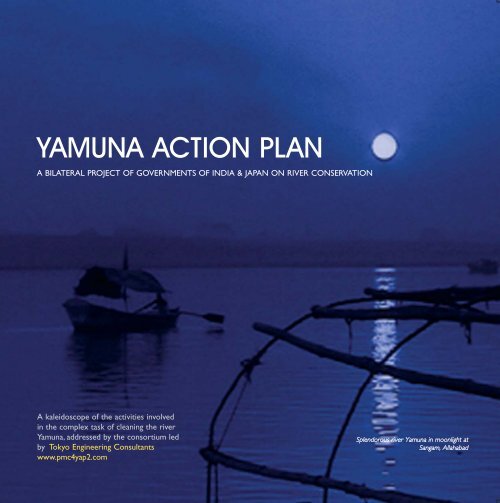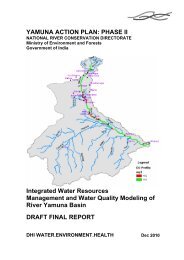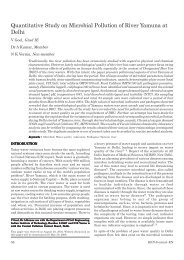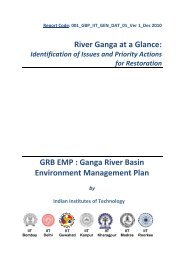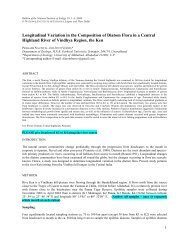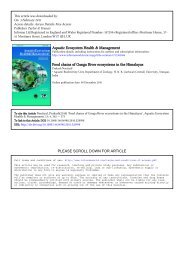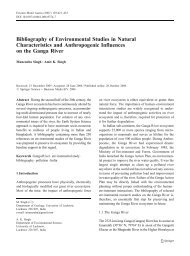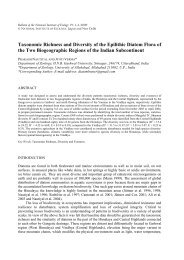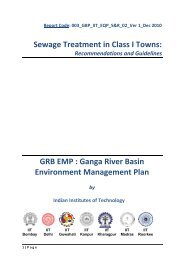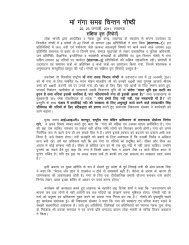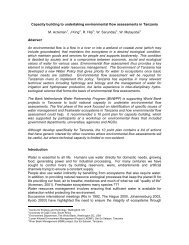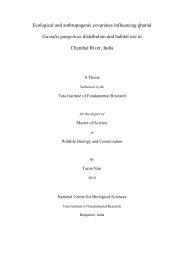YAMUNA ACTION PLAN Vision-document.pdf - GANGAPEDIA
YAMUNA ACTION PLAN Vision-document.pdf - GANGAPEDIA
YAMUNA ACTION PLAN Vision-document.pdf - GANGAPEDIA
Create successful ePaper yourself
Turn your PDF publications into a flip-book with our unique Google optimized e-Paper software.
<strong>YAMUNA</strong> <strong>ACTION</strong> <strong>PLAN</strong><br />
A BILATERAL PROJECT OF GOVERNMENTS OF INDIA & JAPAN ON RIVER CONSERVATION<br />
A kaleidoscope of the activities involved<br />
in the complex task of cleaning the river<br />
Yamuna, addressed by the consortium led<br />
by Tokyo Engineering Consultants<br />
www.pmc4yap2.com<br />
SSpplleennddoorroouuss rriivveerr YYaammuunnaa iinn mmoooonnlliigghhtt aatt<br />
SSaannggaamm,, AAllllaahhaabbaadd
Towns covered under Yamuna Action Plan Project<br />
The River Yamuna<br />
<strong>YAMUNA</strong> is one of the most important and sacred rivers of India. It is the largest<br />
tributary of the river Ganges.The Yamuna river originates from the Yamunotri glacier in<br />
the Mussoorie range of the lower Himalayas.The total length of the Yamuna up to its<br />
point of confluence with the Ganges at Allahabad is 1376 km. Its catchment area is spread<br />
over 366,220 sq. kms. and it falls within the seven States of Uttranchal, Himachal Pradesh,<br />
Uttar Pradesh (U.P.), Haryana, Delhi, Rajasthan and Madhya Pradesh (M.P.).Yamuna has four<br />
main tributaries in the Himalayan region - Rishi Ganga, Hanuman Ganga,Tons, and Giri. In<br />
the plains, the main tributaries are the Hindon, Chambal, Sind, Betwa and Ken. Besides<br />
irrigation, the river is a source of drinking water and bathing and therefore, affects the<br />
habitation of many citizens on its banks.<br />
The combined effect of a modified flow regime due to water holding structures or<br />
barrages, withdrawal of water for irrigation & drinking purposes and the cumulative<br />
discharge of domestic, industrial & agricultural wastewaters has converted the Yamuna<br />
into almost an open sewer in the stretch of Delhi and Agra.As a result, the river is<br />
impacting the bio-diversity of the ecosystem and endangering public health of the<br />
inhabitants.The prevalence of poor sanitation practices also contributes to the<br />
proliferation of a number of diseases and an adverse living environment.<br />
Yamuna water is shared by the four riparian and two basin states under an agreement.<br />
There are three main barrages at Tajewala,Wazirabad-Delhi and Okhla-Delhi which<br />
have been constructed to give effect to this sharing arrangement. Table-1 shows various<br />
reaches of Yamuna River.
Tajewala Barrage (Downstream) Merging Yamuna into Sangam at Allahabad<br />
Tributary-Aglad at Bandarkot<br />
A view of STP at Saharanpur<br />
Table I: REACHES OF <strong>YAMUNA</strong> RIVER<br />
No Reach Segment Length Description<br />
(Km)<br />
I From origin to Himalayan 172 Turbulent stream of almost pristine water quality<br />
Tajewala upto Barrage at Tajewala. Canals on both banks<br />
Barrage withdraw water for various uses.<br />
II Tajewala Upper 224 Dry Weather Flow (DFW) is comprised of fresh<br />
Barrage to water and wastewater from urban and rural<br />
Wazirabad settlements in the catchment.The Barrage at<br />
(Upstream Wazirabad stores water for meeting the demand<br />
of Delhi) of Delhi.<br />
III Wazirabad to Delhi 22 No water is released from the Wazirabad<br />
Okhla Barrage (Highly barrage. The DWF is comprised of wastewater<br />
(Delhi) Polluted) originating in Delhi. The Barrage at Okhla diverts<br />
water through Agra canal to the States of U.P. &<br />
Haryana for irrigation.<br />
IV Okhla Barrage Eutrophicated 490 No water is released from the Okhla barrage.<br />
to confluence (Highly The DWF is comprised of wastewater from<br />
with Chambal<br />
River<br />
Polluted) urban and rural settlements.<br />
V Chambal Diluted 468 The river gets a fresh injection of life after<br />
confluence to dilution from the Chambal water. Other tributaries<br />
confluence with<br />
Ganga river at<br />
Allahabad<br />
coming from Rajasthan and M.P. join in this reach.<br />
RIVER WATER QUALITY<br />
Tajewala in Reach-I is the benchmark where water quality is generally within the desired levels<br />
for bathing quality. Average Biochemical Oxygen Demand (BOD) and Dissolved Oxygen (DO)<br />
levels at this point are 1.2 mg/l and 11.7 mg/l respectively. Downstream of Tajewala, in Reach-II,<br />
domestic and industrial wastewater from urban and rural areas of Yamunanagar-Jagadhri, Karnal,<br />
Panipat, Sonepat, Saharanpur, Muzaffarnagar etc. are discharged into the rivers.Also, a large<br />
quantity of wastewater from livestock rearing activities and surface runoff from agricultural<br />
farms enter the river. However, in this 224 km reach a certain extent of self-purification occurs<br />
and therefore, the water quality upstream of the Wazirabad barrage in Delhi is considered fairly<br />
good.Average BOD in this reach is observed to be in the range of 1.0 - 2.0 mg/l(with slightly<br />
higher values on some occassions). Nevertheless, the level of Coliforms and contamination from<br />
pesticides and industries is of concern.<br />
Reach-III & IV are essentially carrying wastewater and solid waste.The Delhi Reach<br />
(III) is in a unique situation, being located between two barrages and having no fresh water<br />
flows either from upstream or from lateral connections.These stretches have become<br />
extremely critical from a water quality and public health standpoint.The 490 km stretch<br />
downstream of the Okhla barrage up to the confluence with the Chambal River is<br />
characterized as an "open sewer". It is only downstream of Etawah in Reach-V that the<br />
Yamuna recieves dilution water from tributaries bringing improvement in water quality.The<br />
associated Figures-1&2 (See page No. 5) graphically portray the severity of the water<br />
quality condition of the river at different locations in terms of BOD.<br />
<strong>YAMUNA</strong> RIVER POLLUTION CONTROL<br />
Recognizing the gravity of the pollution of rivers, the Government of India (GOI) launched<br />
2 <strong>YAMUNA</strong> <strong>ACTION</strong> <strong>PLAN</strong> <strong>YAMUNA</strong> <strong>ACTION</strong> <strong>PLAN</strong> 3
A view of 78 mld UASB based STP at Agra 20 mld STP at Faridabad<br />
a massive plan for their pollution abatement.The Ganges, being one of the most sacred<br />
and largest rivers in the country, was identified for priority intervention in 1985.The<br />
Yamuna Action Plan Phase-I (YAP-I) project was formulated on the basis of the study<br />
conducted under Special Assistance for Project Formulation (SAPROF) of the Japan Bank<br />
for International Co-operation (JBIC), and covered Delhi, 8 towns of U.P. (Saharanpur,<br />
Muzaffarnagar, Ghaziabad, Noida,Vrindavan, Mathura,Agra and Etawah) and 6 towns of<br />
Haryana (Yamunanagar- Jagadhri, Karnal, Panipat, Sonepat, Gurgaon, and Faridabad). JBIC<br />
provided a soft loan assistance of JPY 17.77 billion (approx. Rs. 700 crore) to the GOI to<br />
initiate YAP-I. Launched in 1993, the project was originally planned to be completed by<br />
April 2000, which was extended until February 2003.<br />
The National River Conservation Directorate (NRCD) under the Ministry of<br />
Environment and Forests (MOEF), GOI is the Executing Agency for the YAP project with<br />
the Uttar Pradesh Jal Nigam (UPJN) in UP, the Public Health Engineering Department<br />
(PHED) in Haryana, the Delhi Jal Board (DJB) and the Municipal Corporation of Delhi<br />
(MCD) in Delhi, are the Project Implementing Agencies (PIAs).<br />
The components of infrastructure involved construction of Drain Interceptors,<br />
Diversion Sewer Lines, Sewage Pumping Stations (PS), and Sewage Treatment Plants<br />
(STP).32 STPs were constructed and a total sewage treatment capacity of about<br />
735 MLD was created.<br />
During the extended phase of YAP-I, more emphasis was given to address various<br />
non-sewerage issues.The strategy for these was formulated under the Special Assistance<br />
for Project Implementation (SAPI) study conducted by JBIC.A Public Participation &<br />
Awareness (PP&A) programme was launched to generate awareness among the<br />
beneficiaries in the project area.The plan also emphasized the creation of Community<br />
Figure 1: Status of Yamuna river water quality.<br />
Tajewala/Hathnikund 1.0<br />
Kalanaur 1.0<br />
Sonipat 1.0<br />
BOD Level<br />
Figure 2: Water quality monitoring sampling stations<br />
4 <strong>YAMUNA</strong> <strong>ACTION</strong> <strong>PLAN</strong> <strong>YAMUNA</strong> <strong>ACTION</strong> <strong>PLAN</strong> 5<br />
Palla 2.0<br />
Nizamuddin Bridge 27.0<br />
Agra Canal 10.0<br />
Mazawali 32.0<br />
Mathura U/S 6.0<br />
Mathura D/S 6.0<br />
Agra U/S 6.0<br />
Agra D/S 39.0<br />
Bateshwar 7.0<br />
Etawah 6.0<br />
Juhika/Auraiya<br />
UDI 2.0<br />
2.0<br />
Desired bathing<br />
class level<br />
(BOD 3 mg/1)
Disinfection Plant (Solar Radiation) at Faridabad 10 mld Oxidation Pond STP at Agra<br />
Community Toilet Complex in Delhi UASB based STP at Faridabad<br />
6 <strong>YAMUNA</strong> <strong>ACTION</strong> <strong>PLAN</strong><br />
Toilet Complexes (CTCs) for low-income groups. In addition, a number of pilot projects<br />
on innovative technologies for decentralised sewage treatment and coliform removal were<br />
also implemented.<br />
A listing of major works implemented in Delhi, U.P. and Haryana states is provided in<br />
Table-2.<br />
Table-2: LISTING OF MAJOR WORKS IMPLEMENTED UNDER YAP-I<br />
Sewerage Interventions:<br />
A. Interception and Diversion of open drains Km 214<br />
B. Sewage Pumping Stations (SPS) Nos. 49<br />
C. Sewage Treatment Plants (STP)<br />
Installations Nos. 28<br />
Capacity creation MLD 722<br />
D. Low Cost Sanitation<br />
Community Toilet Complexes (CTCs) Nos. 1594<br />
E. Pilot Projects<br />
Mini STPs (4 Nos.) MLD 10<br />
Micro STPs (10 Nos.) MLD 0.015<br />
Disinfection of STP effluent based on various technologies(5 Nos.) MLD<br />
Non-sewerage Interventions<br />
8<br />
F. Improved Wood Based Crematoria/Electric Crematoria Nos. 98/2<br />
G. River Front Development (Construction of bathing facilities) Nos. 9<br />
H. Public Participation & Awareness (PP&A) Activities Nos. 7023<br />
LESSONS LEARNED FROM YAP-I<br />
While the wastewater load from Delhi alone was estimated to be 70% of the total load<br />
from 15 urban towns, its coverage was proportionally low under the sewerage<br />
components of YAP. Moreover, the STP capacity created by the Delhi Government<br />
concurrently with YAP remained under-utilised to the extent of 25-45% because of<br />
severe limitations in the collection system.As a result, untreated sewage continued to<br />
flow into the river through a series of storm water drains.<br />
Similarly, some of the STPs in Reaches II and IV remained under-utilised due to a<br />
combination of limitations in the collection system and power availability. Municipalities<br />
and agencies which were responsible for Operation & Maintenance (O&M) of sewerage<br />
infrastructure were constrained to maximize the operational efficiency of the system<br />
due to a combination of factors related to skills, finance, management systems, power<br />
cuts and upstream sewerage infrastructure.<br />
The strategy in YAP-I did not adequately address non-point sources of pollution such as<br />
Dairy Farms, Dhobhighats, Slaughterhouses, etc.<br />
The Community Toilet Complexes prevented to a certain extent the practice of open<br />
defecation and yielded consequent benefits in terms of improved hygiene and sanitary<br />
conditions of project towns.<br />
When YAP-I schemes were being designed, the wastewater discharge standards did not<br />
mandate STP effluents to comply with any bacteriological water quality standards.The<br />
norms for coliform reduction stipulated after approval of the schemes for treatment.As<br />
a result, the STPs did not include effluent disinfection systems.<br />
In YAP-I the major consideration was to target and control immediate pollution loads<br />
from the domestic sector.Accordingly, whatever sewage treatment capacity was<br />
<strong>YAMUNA</strong> <strong>ACTION</strong> <strong>PLAN</strong> 7
8 <strong>YAMUNA</strong> <strong>ACTION</strong> <strong>PLAN</strong><br />
2.25 mld STP at Agra Site of YAP project Shram Dan by School Children in Vrindavan Workshop on Sensitization about PP&A programme<br />
created, it was designed for 1998 population loads.<br />
A pilot project in Agra Nagar Nigam was undertaken to enhance the revenue<br />
generation by conceptualizing the best practices from other ULBs in the country. Its<br />
successful implementation and sustained municipal reform measures were achieved by<br />
working in the area of property tax, private sector participation in O&M of municipal<br />
services, etc.<br />
YAP-II: THE PROJECT CONTINUATION AND ENHANCEMENT<br />
PHASE<br />
Building on the success and lessons learned from YAP-I, a new Loan Agreement between<br />
GOI and GOJ was signed on March 31, 2003 for the current YAP-II project.The JBIC<br />
Loan Agreement provided financial assistance of JPY 13.33 Billion (approx. Rs. 500<br />
Crore or approximately 85 percent of the overall project budget) to increase sewage<br />
collection and treatment capacities by constructing new & rehabilitating old sewage<br />
treatment plants and rehabilitating & installing sewers in Delhi and Agra. Besides the 15<br />
JBIC assisted YAP-I towns, two more towns, Bahadurgarh and Rohtak of Haryana have<br />
also been added in YAP-II for the preparation of Master Plan (M/P), Feasibility Study(<br />
F/S), Detailed Project Reports (DPRs) for YAP-III.The YAP-II project commenced on<br />
December 1, 2004 with the appointment of PMC.The project is to be completed by<br />
November 2009.<br />
YAP-II envisages a two fold strategies in pollution control and abatement for<br />
Yamuna:<br />
Implement schemes, which have visible and tangible impact on the immediate<br />
improvement of water quality of the river.<br />
Carry out planning activities for future such as preparation of M/P, F/S and DPRs for<br />
YAP-III<br />
Synchronize engineering and non-engineering components<br />
Specific value-added-components included in YAP-II are as follows:<br />
PP&A Programmes on public involvement in decision making process by utilizing<br />
numerous NGOs<br />
Public Relations / Information Programme in Delhi<br />
Engineering Technology Transfer to ULBs in Haryana<br />
Institutional Strengthening & Capacity Building of the 15 ULBs<br />
Capacity Building for NRCD, which is the Executing Agency for the project<br />
Water Quality Monitoring Programme<br />
Table-3 summarizes the scope of programmes and budget included in YAP-II, with Delhi as<br />
the major polluter receiving a proportionally higher share.<br />
INNOVATIONS IN YAP-II<br />
Adopting Trenchless Technology for Delhi Trunk Sewers<br />
For many years, the conventional method for construction of sanitary sewers to collect<br />
wastewater has been trenching or open-cut excavation. New methods of obtaining<br />
geotechnical data and the development of new equipment have resulted in the adoption of<br />
innovative trenchless (no-dig) approaches involving earth boring, pipe jacking or microtunneling<br />
techniques with a minimum or no surface excavation.This new construction<br />
method results in social costs being reduced to a nominal amount compared to the opencut<br />
methods. Such technology is being adopted for rehabilitation and new construction of<br />
three major Trunk Sewers in Delhi under YAP-II programme.<br />
<strong>YAMUNA</strong> <strong>ACTION</strong> <strong>PLAN</strong> 9
India Gate -Heritage of Delhi- the Capital Used offering to Yamuna - Lack of Awareness Taj, Yamuna & Pollution Infant being buried into Yamuna<br />
10 <strong>YAMUNA</strong> <strong>ACTION</strong> <strong>PLAN</strong><br />
Table-3: SCOPE OF PROGRAMME AND BUDGET INCLUDED IN YAP-II<br />
S No. NAME OF STATE/SCHEME Estimated Cost<br />
(Rs in millions)<br />
I DELHI 3871.7<br />
1. Physical Works Implementation<br />
a. Okhla STP<br />
b. Keshopur STP<br />
c. Bela Road Trunk Sewer<br />
d.Wazirabad Road Trunk Sewer<br />
e. Ring Road Trunk Sewer<br />
2 Preparation of Master Plan (M/P), Feasibility Study (F/S), Detailed Project Report<br />
(DPR) for YAP- III<br />
a. Decentralized Wastewater Treatment for Water bodies (including Pilot Project)<br />
b. Dairy Farm Waste Management (including Pilot Project)<br />
c. Dhobighat Sudhar Yojna (including Pilot Project)<br />
d. Slaughterhouse Modernisation and Waste Management<br />
e.Antim Niwas Sudhar Yojna (including Pilot Project)<br />
f. Slum Rehabilitation Study<br />
3. Public Participation & Awareness (PP&A)<br />
a. Clean Yamuna Manch<br />
b. Other PP&A Programme (Socio Economic & Environmental upgradation Program, School<br />
Health & Hygiene Program and Innovative Program)<br />
4. Public Relations (PR)<br />
5. Institutional Strengthening & Capacity Building of MCD<br />
a. Property Tax, Public Participation in solid waste, operation of CTCs etc.<br />
b. Usage of High Resolution Satellite Imagery<br />
c.Training of Sugam Kendra Staff<br />
II UTTAR PRADESH 1241.3<br />
1. Physical Works Implementation<br />
Sewerage Works (Sewers, Sewage Pumping Stations, Rising Mains, STPs) in<br />
Northern & Western zones at Agra<br />
Preparation of Master Plan (M/P), Feasibility Study (F/S), Detailed Project Report<br />
(DPR) for YAP- III (8 towns)<br />
2. Public Participation & Awareness (PP&A)<br />
a. Clean Yamuna Manch at Agra<br />
b. Other PP&A Programme (Socio Economic & Environmental upgradation<br />
Programme, School Health & Hygiene Programme and Innovative Programme)<br />
3. Institutional Strengthening & Capacity Building of 7 ULBs and Noida Authority<br />
III HARYANA 625.0<br />
1. Engineering Technology Transfer (ETT) to ULBs (6 towns)<br />
2. Preparation of Master Plan (M/P), Feasibility Study (F/S), Detailed Project Report<br />
(DPR) for YAP- III (8 towns)<br />
3. Public Participation & Awareness (PP&A)<br />
4. Institutional Strengthening & Capacity Building of 6 ULBs<br />
IV CAPACITY BUILDING OF NRCD 502.0<br />
1. MIS,Accounting & State-of-Art Equipments etc<br />
2. Water Quality Monitoring Programme<br />
a. Upgradation of Laboratories<br />
b. Integarated Water Resource Management and Water Quality Modeling including setting up<br />
of on-line monitoring location<br />
c. Upgardation of one STP as model STP and Traning for O&M in STP<br />
TOTAL 6240.0<br />
<strong>YAMUNA</strong> <strong>ACTION</strong> <strong>PLAN</strong> 11
Mr. Naresh Dayal, AS&PD, NRCD, MoEF<br />
12 <strong>YAMUNA</strong> <strong>ACTION</strong> <strong>PLAN</strong><br />
A Workshop on Dissemination of Trenchless Technology in Delhi Water Quality of River Yamuna Layout Plan of Okhla STP in Delhi Layout Plan of Keshopur STP in Delhi<br />
On Decmber 14, 2005 a workshop was held in Delhi involving several internationally<br />
renowned participants organized by the Project Management Consultant (PMC) on the<br />
subject of "YAP-II and Beyond:A Workshop on Dissemination of Trenchless Technology in<br />
India" with the purpose of sharing the information with the experts worldwide on<br />
adoption of Trenchless Technology in the YAP-II programme in Delhi.<br />
Information Technology (IT) in YAP-II<br />
IT is no longer a business resource; it is the business environment.Various tools of IT are being<br />
used in the project to enhance the quality of work under the project.An interactive website<br />
(www.pmc4yap2.com) has been developed by PMC to provide information on the project.<br />
Management Information System (MIS)<br />
MIS will allow all technical and managerial data to be summarized for timely transmissions<br />
of progress reports for the decision making of the Executive Agency.<br />
For providing such information in a concise manner suitable for all formal reporting<br />
requirements, key functions of the MIS will include reports for tracking activity status,<br />
schedule, quality control and progress reports, as well as the database applications for<br />
correspondence logs, contract administration and accounting.<br />
Geographical Information System (GIS) based web-enabled MIS<br />
This system will facilitate decision making to take corrective actions and also to easily<br />
understand the overall position of the project at any point of time through various GIS maps.<br />
Integrated Water Resource Management and Water Quality Modelling<br />
Integrated water resource management of the Yamuna basin will be developed through a<br />
water quality model, and this will be linked with GIS.This component also includes<br />
setting up an online monitoring system on a pilot basis and establishment of a data<br />
transmission network.<br />
Video Documentation<br />
This vital tool for the real-time <strong>document</strong>ation is proposed to be used for effective<br />
monitoring and implementation of project activities at various stages and to provide<br />
decision making support to the stakeholders.<br />
A series of seminars and workshops is also being organized for various stakeholders<br />
throughout the project period.<br />
PROJECT COMPONENTS UNDER YAP-II<br />
PHYSICAL WORK IMPLEMENTATION IN DELHI<br />
Okhla Sewage Treatment Plant<br />
As per TCE's M/P for the Okhla Sewerage Zone, the total flow would be 765 MLD.<br />
Presently, there are five STP modules totaling 630 MLD capacity at Okhla. Under YAP-II,<br />
one new STP module of 135 MLD capacity will be constructed along with a power<br />
generation plant on the existing premises.<br />
Keshopur Sewage Treatment Plants<br />
The Keshopur STP Project consists of rehabilitation of three plant modules which were<br />
constructed at one location in the Keshopur drainage zone between 1956 and 1988 with<br />
capacities of 54 MLD, 90 MLD and 180 MLD respectively.As these modules are not<br />
functioning properly, the partially treated/untreated wastewater is discharged into the<br />
Najafgarh drain and consequently polluting the Yamuna.<br />
In YAP-II, the above three modules are to be rehabilitated in conjunction with<br />
construction of some new process units to meet system requirements, and a power<br />
generation plant utilizing biogas.<br />
<strong>YAMUNA</strong> <strong>ACTION</strong> <strong>PLAN</strong> 13
Layout Plan of Bela Road Trunk Sewer<br />
14 <strong>YAMUNA</strong> <strong>ACTION</strong> <strong>PLAN</strong><br />
Congested alignment of Wazirabad Road Trunk Sewer Damaged Ring Road Trunk Sewer<br />
Bela Road Trunk Sewer<br />
Installation of the Bela Road Trunk Sewer consists of a conduit ranging in size from 500<br />
mm to 600 mm with an overall length of 3.4 kms.<br />
Wazirabad Road Trunk Sewer<br />
The Wazirabad Trunk Sewer involves construction of a conduit ranging in size from 450<br />
mm to 2000 mm, with an overall length of 15.2 kms.<br />
Ring Road Trunk Sewer<br />
Rehabilitation of the Ring Road Trunk Sewer consists of a conduit ranging in size from<br />
1200 mm to 2700 mm with an overall length of 11.6 kms.<br />
PREPARATION OF MASTER <strong>PLAN</strong> (M/P), FEASIBILITY STUDY<br />
(F/S), DETAILED PROJECT REPORT (DPR) FOR YAP- III IN<br />
DELHI<br />
Decentralized Wastewater Collection and Treatment for Water Bodies<br />
(Including Pilot Project)<br />
Under this scheme, installation of decentralized wastewater collection/ treatment / and<br />
effluent reuse systems to intercept polluting wastewater flow in water bodies e.g. lakes<br />
and ponds, not served by the centralized sewerage systems, will be studied supported by<br />
pilot implementation.This will revitalize the water bodies of Delhi, enabling the public<br />
open spaces to provide multiple environmental benefits including potential ground water<br />
recharge.<br />
Dairy Farm Waste Management (Including Pilot Project)<br />
A large number of clusters of dairy farms located in the towns and cities along the river<br />
are directly discharging the cattle dung and liquid wastes into the river. There are ten<br />
Dairy Farm Waste in Delhi Washer-men on the banks of the river Yamuna in Delhi<br />
authorized clusters of dairy farms in Delhi, which are located on the outskirts. Some of the<br />
larger clusters are at Gazipur, Najafgarh and MadanpurKhadar. Besides these authorized<br />
farms, there are still a large number of unauthorized dairies operating in and around the<br />
city. It is estimated that in 12 different zones of MCD, there are 21 unauthorized dairy<br />
clusters with over 2811 unauthorized dairy units having more than 40,000 head of cattle.<br />
The dung generated from these units is of the order of 380 tonnes/day.<br />
It is estimated that over three fourths of waste generated at these diary clusters finds<br />
its way into the river Yamuna through the local surface drains.This corresponds to a BOD<br />
pollution load of over 48 tonnes/day from Delhi alone.<br />
Through this component it is anticipated that alternative use practices can be<br />
examined and better management of the dairy waste can be effected, converting the waste<br />
into an asset to the community and at the same time reducing the pollution load on the<br />
river.The long-term objective of the project is to help control discharge of organic<br />
pollutants from dairy farms in Delhi, leading to improvement in the river water quality.<br />
Towards its achievement it may be necessary to incorporate appropriate technology<br />
solutions addressing key concerns for logistics, public participation, institutional and<br />
financial sustainability.<br />
Dhobighat Sudhar Yojna (Including Pilot Project)<br />
The washer-men (Dhobi) community, residing largely on the banks of the river Yamuna,<br />
derives their sustenance from laundry operations. In Delhi, a huge quantity of clothes<br />
from residences, hospitals, industries etc. are being washed at constructed/ traditional<br />
Dhobighats either on the banks of the river Yamuna or near canals/ nallahs by utilising<br />
river water or water supplied from other sources.Almost the entire activity is<br />
unorganised and performed by individual washer-men and their family members.The<br />
<strong>YAMUNA</strong> <strong>ACTION</strong> <strong>PLAN</strong> 15
16 <strong>YAMUNA</strong> <strong>ACTION</strong> <strong>PLAN</strong><br />
A view of Dhobighat Slaughterhouse at Idgah in Delhi Improved wood based crematorium at Faridabad Slum squatter settlements located in riverbeds<br />
required infrastructure for washing, drying etc. is not available adequately at most of the<br />
Dhobighat sites.The wastewater including large quantity of soap, detergents, chemicals,<br />
etc. discharged from the sites eventually drains directly or indirectly into the river<br />
Yamuna resulting in water pollution. In order to prevent river pollution from the<br />
sources, it is necessary to carry out a detailed situation analysis involving all relevant<br />
stakeholders and to prepare a M/P for improving the existing conditions of all the<br />
Dhobighats in Delhi.The pilot intervention for developing the model Dhobighat would<br />
be implemented with participation of a Dhobi community, which could be replicated for<br />
all the Dhobighats.<br />
Slaughterhouse Modernisation and Waste Management<br />
There is only one authorized slaughterhouse in Delhi, the Idgah Abattoir located near<br />
Karol Bagh and Paharganj.This slaughterhouse is more than 100 years old and does not<br />
have any modern equipment for slaughtering animals and meat processing.There is no<br />
authorised slaughterhouse for meeting the demand of chicken, meat etc.This situation<br />
coupled with the poor state of infrastructure available at Idgah and in the city in general is<br />
a cause of concern with regard to ensuring hygiene, food safety and environment<br />
protection. Currently a major quantity of the solid waste from the slaughterhouses is<br />
disposed in the Gazipur landfill site.The entire wastewater from these slaughterhouses is<br />
discharged untreated into open drains/sewers, which eventually join the Yamuna. MCD has<br />
already taken up a project to modernize the Idgah Abattoir.<br />
Under this project component, an integrated M/P will be developed on all existing<br />
authorized and unauthorized slaughterhouses.This will be done by the collection of data<br />
to review the existing systems, situation analysis with available <strong>document</strong>s and information<br />
with physical verification and investigation work.A Detailed Strategy Study Report will<br />
also be prepared to depict the existing infrastructure facilities, measure the problems and<br />
suggest the modernization system as well as recommend the appropriate techniques for<br />
treatment of various wastes.<br />
Antim Niwas Sudhar Yojna (including Pilot Project)<br />
The cremation of dead bodies on the banks of the river Yamuna is a traditional practice in<br />
the Hindu religion. In case of infant/ young children, dead bodies are buried in the<br />
river rather than cremated. Largely, the poor often release un-burned or half-burned<br />
dead bodies to the river due to lack of adequate resources for funerals. However, the<br />
animals are buried/ disposed of in the open space or drains/ nallahs, or riverside since there<br />
is no animal crematorium in Delhi.All these factors contribute to further pollution of the<br />
Yamuna.<br />
In order to ensure prevention of river pollution, there is a need to carry out a<br />
situation analysis involving all relevant stakeholders and to prepare a M/P for improving<br />
the existing conditions of all the Crematoria/ Cremation Grounds in Delhi.The need/<br />
priority based activity would be undertaken for environmental upgradation of existing<br />
crematoria.<br />
Slum Rehabilitation Study<br />
Slum squatters settlements located in riverbeds, eastern and western embankments, on all<br />
the major drains of the capital city of Delhi and other colonies drains as well as drains from<br />
vulnerable and depressed areas where large slum clusters are located, also considerably<br />
contribute to the pollution load of Yamuna. Slum as a pollution source has been a serious<br />
cause of concern and has been repeatedly observed by the Honorable Delhi High Court<br />
and Honorable Supreme Court.<br />
Under YAP-II, a slum rehabilitation study is to be conducted to understand the various<br />
<strong>YAMUNA</strong> <strong>ACTION</strong> <strong>PLAN</strong> 17
18 <strong>YAMUNA</strong> <strong>ACTION</strong> <strong>PLAN</strong><br />
Typical slums in Delhi Layout Plan of 14 MLD STP at Agra<br />
perspectives related to resettlement & rehabilitation of slums squatters sites in Delhi<br />
including a socio-economic survey<br />
PUBLIC RELATIONS (PR)<br />
As part of YAP-II, PR activity is mainly focused on operations of the DJB with emphasis on<br />
improving the visibility, brand image and public acceptability of YAP- II infrastructure<br />
schemes for abating pollution in the Yamuna River Basin.The PR activities will mainly<br />
cover the areas of the trunk sewer and STP projects to be constructed.The following<br />
objectives are expected to be achieved through the PR activities:<br />
Enhance public awareness and educate citizens on the Yamuna, Delhi's lifeline - its<br />
current status, sources of pollution and mitigation measures.<br />
Influence public perception, attitude, practice and involve stakeholder groups in caring<br />
for the Yamuna.<br />
Bridge perception gaps.<br />
Disseminate information to stakeholders.<br />
Upgradation / Improvement of the existing Consumer Redressal System with<br />
feedback to consumer<br />
Upscale of Water Harvesting System with systematic information, cost details etc.<br />
To address water leakage effectively.<br />
Educate public about the measures being taken to abate river pollution.<br />
PHYSICAL WORK IMPLEMENTATION IN U.P.<br />
Sewerage Works at Agra<br />
Agra city is divided into eight sewerage zones of which the Northern & Western<br />
Inaugural Ceremony of DHS Bio-tower at Karnal A view of Bio-tower at Karnal<br />
Sewerage Districts have been selected for the physical implementation of works under<br />
YAP-II.The population projection for the design years of 2007, 2017 and 2037 are<br />
calculated on the basis of census population of 1.24 million in 2001.<br />
The physical works to be implemented in Agra will serve a total population of<br />
4, 22, 615 (2017) in two sewerage zones.<br />
Northern Zone: 35.5 kms of Sewers, 2 Pumping Stations, 5.25 kms of Rising Main, and<br />
a 14 MLD STP to serve a population of 1,21,425.<br />
Western Zone: 35 kms of Sewers, 3 Pumping Stations, 9.5 kms of Rising Main, and a<br />
40 MLD STP to serve a population of 3,01,190.<br />
ENGINEERING TECHNOLOGY TRANSFER TO URBAN LOCAL<br />
BODIES IN HARYANA<br />
Under YAP-I, sewerage facilities were created in six towns of Haryana:Yamunanagar-<br />
Jagadhri, Karnal, Panipat, Sonepat, Faridabad and Gurgaon.The responsibility for O&M of<br />
these assets is vested with the respective ULB in each town.To operate & maintain such<br />
assets properly, the techno-managerial resources / capacity of such ULBs are needed to be<br />
enhanced.With this in mind, "Engineering Technology Transfer to ULBs" has been initiated<br />
under YAP-II.<br />
To enhance the process of ETT to ULBs, there will be a field training programme to<br />
train ULB engineers and technical staff on various aspects of sewerage works.To facilitate<br />
wide exposure of different components of the sewerage systems, construction of new<br />
systems with sewers of varied diameter & length, ancillary structures like pumping<br />
stations, and upgrading of electro-mechanical systems etc. have been proposed to be<br />
included in the training program.<br />
<strong>YAMUNA</strong> <strong>ACTION</strong> <strong>PLAN</strong> 19
Cultural Activity by School Children in PP&A Programme Children Participation in Awareness Programme<br />
20 <strong>YAMUNA</strong> <strong>ACTION</strong> <strong>PLAN</strong><br />
This is the most effective method of transfer of knowledge/skills through on the job<br />
training and practical applications. It is essentially learning by doing and enables day-to-day<br />
association, interaction and communication with PHED/ ULBs Engineers and the consultants.<br />
PREPARATION OF M/P, F/S, & DPR OF WASTEWATER SCHEMES<br />
IN U.P. and HARYANA<br />
M/P for sewerage and drainage works, F/S and DPR for sewerage work will be prepared<br />
for the identified 8 towns in U.P. and 8 towns in Haryana.All the existing works including<br />
YAP-I will be integrated under the M/P, the design period for which will be 30 years. F/S<br />
will focus on the priority works from the M/P. In addition, DPRs will be prepared for<br />
implementation under YAP-III.<br />
PUBLIC PARTICIPATION & AWARENESS (PP&A) IN DELHI,<br />
U.P. AND HARYANA<br />
PP&A is a pivotal component, realizing its significance in making projects sustainable.<br />
Specific objectives include promotion of different prevention and management measures,<br />
optimal utilisation and maintenance of created facilities and strengthening of effective coordination<br />
among PIAs, ULBs & NGOs/ CBOs and the community.The four specific<br />
programmes as mentioned below are being implemented through partner NGOs in the<br />
selected project towns.<br />
Clean Yamuna Manch in Delhi and Agra<br />
This is a special drive to complement/ supplement the PP&A component through mass<br />
awareness, policy initiatives, advocacy, networking, research, media, <strong>document</strong>ation, and<br />
information dissemination. Strategic targeted interventions are carried out to mobilize<br />
Shram Dan by volunteers in Vrindavan World Water Day celebration in Vrindavan<br />
various stakeholders including community leaders, political elected representatives,<br />
relevant government organisations, educational institutions/ universities, media groups,<br />
corporate sectors, national and international organisations, and general public towards the<br />
promotion of Clean Yamuna.<br />
Other PP&A Programs in all three states<br />
Socio-economic and Environment Upgrading of CTC Neighbourhood Community<br />
Programme:<br />
Emphasis of the programme is promoting hygienic sanitation practices in CTC<br />
neighbourhood communities through community acceptance and optimum utilisation of<br />
existing sanitation facilities in order to strive for 'Zero Pollution' service areas. Broad<br />
activities comprise awareness and sensitisation campaigns of community members, hygiene<br />
and sanitation education, capacity building, establishing linkages and creating an<br />
environment for community based intervention.<br />
School Health and Hygiene Programme:<br />
Special thrust of the programme is to develop responsible behaviour amongst school<br />
children and promote them as change agent for prevention and management of river<br />
pollution.The awareness generation and knowledge upgrading on river water pollution,<br />
solid waste and wastewater management are considered instrumental for children to act<br />
as change agents at their school, home and surrounding environment where they live.<br />
Town Specific Innovative Programme:<br />
The programme is to support specific socio-cultural and community initiatives/<br />
experiments/ innovative efforts on issues related to community health, hygiene, sanitation,<br />
environment pollution & conservation with small financial investments, short duration and<br />
scope for sustainable replication and up-scaling at the larger context.<br />
<strong>YAMUNA</strong> <strong>ACTION</strong> <strong>PLAN</strong> 21
Orientation Programme of ULBs at Delhi<br />
22 <strong>YAMUNA</strong> <strong>ACTION</strong> <strong>PLAN</strong><br />
INSTITUTIONAL STRENGTHENING & CAPACITY BUILDING<br />
(ISCB) OF ULBs IN DELHI, U.P. AND HARYANA<br />
ISCB of the ULBs under YAP-II is an important value added constituent.This programme<br />
encompasses enhancement of institutional financial and human resources capacities of the<br />
14 ULBs and Noida Authority to ensure that they undertake the responsibility of O&M of<br />
assets created under YAP-I in a sustainable manner.The positive results and lessons learnt<br />
from the Pilot Reform Fund project initiated in Agra under YAP-I will be incorporated into<br />
the YAP-II programme.<br />
Usage of High Resolution Satellite Imagery<br />
To encourage the creation of common reference maps for the towns in which the<br />
projects are being undertaken, recent high-resolution satellite imagery is being acquired<br />
and would be provided to the PIAs for the project works. Using this approach the maps<br />
of the existing and proposed sewerage system will be superimposed on a correctly georeferenced<br />
base map making it possible for the ULBs to systematically add and correlate<br />
other spatial information for their routine activities.<br />
The high-resolution satellite imagery of the entire cities and towns will be used as the<br />
foundation to develop a comprehensive Property Tax System, which would facilitate<br />
strengthening of the revenue collection system of ULBs. In addition, this imagery will also<br />
be used to <strong>document</strong> the information on Slum Areas, Dairy Farms, Dhobighats,<br />
Crematoria, Slaughterhouses, Urban Water Bodies etc. in Delhi.<br />
Training of Sugam Kendra Staff of MCD<br />
MCD intends to leverage information and communication technologies to provide<br />
efficient, affordable, accountable and transparent municipal services to the people of<br />
Delhi.Training will be imparted to the officers and staff who are responsible for<br />
Satellite Imagery of Delhi Analysis of Water Samples Upgradation of Water Quality Laboratories<br />
interfacing with the public and providing necessary information and services pertaining<br />
to civic activities.<br />
This initiative will bring the MCD's e-governance programme into public focus and<br />
help in their success through thirteen specially developed Citizen Service Bureaus<br />
covering 134 wards.This unique public service initiative of MCD will provide<br />
comprehensive citizen services under one roof through computerized systems that are<br />
connected to the Internet.<br />
CAPACITY BUILDING OF NRCD<br />
MIS,Accounting & state-of-art equipments etc.<br />
An organization of the nature and magnitude of the NRCD requires state-of-art<br />
equipment and tools such as a Management Information System (MIS), efficient Project<br />
Management System and a robust Accounting System for constant monitoring, feedback<br />
and corrective interventions.<br />
Water Quality Monitoring Programme<br />
The Yamuna River Basin Water Quality Monitoring Programme will provide the necessary<br />
background information for assessing the effectiveness of the pollution abatement<br />
programmes undertaken.This information will also help in better formulation of the<br />
directions for subsequent programmes in reducing the pollution load and developing a<br />
more comprehensive relationship between project execution and resultant improvement<br />
in the river water quality.<br />
Under the YAP-II programme, this project activity will address:<br />
Augmentation / upgrading of STP laboratories (installed during YAP-I) and zonal<br />
laboratories.<br />
<strong>YAMUNA</strong> <strong>ACTION</strong> <strong>PLAN</strong> 23
24 <strong>YAMUNA</strong> <strong>ACTION</strong> <strong>PLAN</strong><br />
Information Dissemination<br />
A Forwarding Step in Indo-Japanese friendship<br />
Development of a model for flow and pollution studies and a decision support system for<br />
integrated water resource management and control of pollution in the Yamuna basin.<br />
O&M training to the staff and operators of STPs.<br />
OPERATION & MAINTENANCE (O&M) STUDY OF FACILITIES<br />
CONSTRUCTED UNDER YAP-I<br />
The objective of the O&M study is to enhance the capability and efficiency of YAP-I towns<br />
to better operate, manage and maintain their wastewater systems.The improvements<br />
identified through the O&M study are intended to increase O&M efficiency, ensure better<br />
health and safety of the staff involved and to develop capacity for sustainable O&M.<br />
Under Special Assistance for Project Sustainability (SAPS), a study was conducted and<br />
workshop was organized on O&M on December 15, 2005.<br />
Lessons learned from the O&M review of the YAP-I infrastructure can be<br />
incorporated in the implementation of YAP-III schemes.<br />
PROJECT MANAGEMENT CONSULTANTS (PMC)<br />
To undertake the implementation of the Yamuna Action Plan-II, the NRCD appointed TEC<br />
Consortium led by Tokyo Engineering Consultants Co. Ltd., Japan (TEC), an exclusive<br />
water sector consulting firm since 1959, as the Project Management Consultants. Other<br />
members of consortium included R V Anderson Associates,TCE Consulting Engineers<br />
Limited, Development Consultant Pvt. Ltd. and PricewaterhouseCoopers Pvt. Ltd.The<br />
PMC started their services on December 1, 2004.<br />
The role of the PMC is to assist NRCD, JBIC and PIAs in the implementation of YAP-<br />
II project.<br />
Implementation Framework of YAP-II
Pollution in Yamuna has been constantly engaging<br />
the efforts and attention of the Government and<br />
Yamuna Action Plan - II is one of the major River<br />
Action Plans being implemented by the<br />
Government of India.<br />
We feel proud to have JBIC as a partner in this<br />
endeavour.The synergy of the multitude of<br />
institutions involved and their sincere efforts<br />
would no doubt help in achieving a cleaner<br />
Yamuna.<br />
I congratulate the PMC for bringing out this nice<br />
booklet / brochure which would give a quick<br />
account of facts about the project.<br />
Addl. Secretary & Project Director<br />
National River Conservation Directorate, New Delhi<br />
It is our privilege to support Yamuna Action Plan<br />
Phase -II Project, which has a pragmatic approach<br />
towards improving the quality of water in the River<br />
Yamuna and the living environment in the cities<br />
along the river.We are hopeful that project will not<br />
only result in a 'Clean Yamuna' but also be a role<br />
model for other River Cleaning campaigns in India.<br />
Chief Representative<br />
Japan Bank for International Cooperation, New Delhi<br />
We are proud to have an ongoing participatory<br />
role in implementing this multi-faceted and<br />
comprehensive pollution abatement programme<br />
on the great Yamuna River.This enables us to<br />
create a healthier & sustainable urban<br />
environment, and restoration of critical water<br />
resources in India.<br />
Project Manager<br />
Project Management Consultants, New Delhi<br />
With a vision to make Yamuna waters pristine, we<br />
dedicate all our best, enthusiastic and professional<br />
efforts on such a great challenging project on River<br />
Yamuna.We are sincerely committed to achieve<br />
this goal.<br />
Resident Representative<br />
Project Management Consultants, New Delhi<br />
Further information on the Yamuna Action Plan project may be obtained from:<br />
National River Conservation Directorate<br />
Ministry of Environment & Forests<br />
Government of India<br />
Paryavaran Bhawan<br />
CGO Complex, Lodi Road,<br />
New Delhi-110003 (INDIA)<br />
Tel: +91-11-2436 2206<br />
Fax: +91-11-2436 0009<br />
URL: www.yap.nic.in<br />
Further information on the Japan Bank For International Cooperation may be obtained from:<br />
Japan Bank For International Cooperation<br />
3rd Floor, DLF Centre, Sansad Marg,<br />
New Delhi-110001 (INDIA)<br />
Tel: +91-11-2371 4362/63<br />
Fax: +91-11-2371 5066<br />
URL: www.jbic.go.jp<br />
Further information on the TEC-led Project Management Consultant may be obtained from:<br />
Tokyo Engineering Consultants Consortium<br />
Dr. Lalit K.Agrawal<br />
Resident Representative<br />
149, Sukhdev Vihar,<br />
New Delhi 110025 (INDIA)<br />
Tele/Fax.: +91-11-2693 2607 / 2693 2609<br />
URL: www.pmc4yap2.com<br />
Any information on the Lead Consultants may be obtained from:<br />
Tokyo Engineering Consultants Co., Ltd.<br />
Mr. Masafumi Miyamoto<br />
Director (Overseas Division)<br />
Fuji Bldg., 7-4 Kasumigaseki, 3-Chome, Chiyoda-Ku<br />
Tokyo 100-0013 (JAPAN)<br />
Tele: +81-3-3580 2418<br />
Fax: +81-3-3591 0492<br />
URL: www.iijnet.or.jp/tec-jimu<br />
design: CMYK 9811154639


